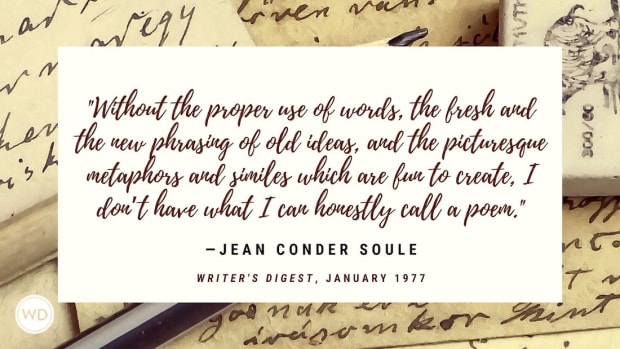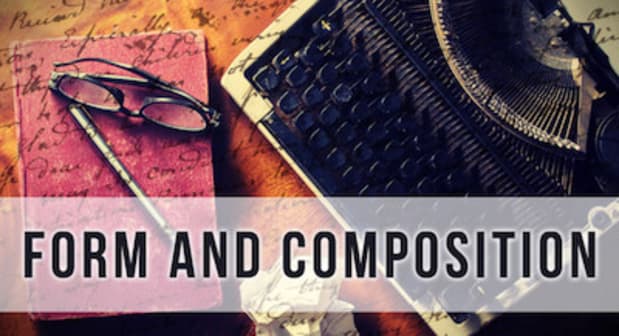In this article from 1977, children’s writer and poet Jean Conder Soule explores the question, “How will I know when I’ve written a poem?”
Writer’s Digest, January 1977
By Jean Conder Soule

When I first began to write poetry (more years ago than I would care to mention), one of the questions I asked myself and my teachers was, “How will I know when I’ve written a poem?” I was worried that perhaps my words were, at best, merely poetic prose.
Since then, I’ve written serious poetry and have had some of it published; I’ve dabbled in light verse and humor and have seen many of my couplets and quatrains appear in leading magazines and newspapers. But still, the question haunts me, and I’ll bet it bothers some of you, too: How can I tell when I’ve written something that’s truly a poem? By the way it looks on the typed page? No, not necessarily. By the way the long and the short lines vary in a rhythmic pattern? Perhaps by the natural pauses at the end of the free verse lines? Maybe, but not always.
So, what is it that makes me sure I’ve written poetry and not poetic prose? It’s the diction of the poem. Without the proper use of words, the fresh and the new phrasing of old ideas, and the picturesque metaphors and similes which are fun to create, I don’t have what I can honestly call a poem.
Too many beginning poets can’t express what they want to say within the boundaries of meter and rhyme. It is so easy to be trapped in the cage of these two devices. If you are not careful, your rhymes will sound forced and your meter will limp because you must use only words that fit. You can’t use that lovely three-syllable adjective that you feel is just right—it will throw your meter off. So you have to settle for second best. And you will make inversions in grammar—upsetting the natural order of your sentence—for the sake of your rhyme.
I’m not saying that poets should never rhyme. But I do say that you should begin with unrhymed forms like the Japanese haiku or the tanka until you are comfortable with poetic diction. In the Japanese forms, it is especially important to develop word pictures through imagery, mainly metaphor and simile. The haiku and tanka lend themselves well to this exercise. Their short, syllabic patterns demand that the writer express himself in condensed, precise, effective language. The haiku is like a little telegram that depicts for the reader something momentous that has happened in nature, in the seasons, or in the poet’s own life. It’s excellent for learning to use imagery in modern terms and for avoiding cliches, archaic words, and trite expressions which so often clutter the work of beginning poets.
One of my students once said in defense of her “dated” poem, “Tennyson and Shakespeare, Shelley and Keats used the words I’m using—and surely, what’s good enough for them is good enough for me!” I had a hard time convincing her that she would do far better to use the vernacular—our everyday language. I had to agree that in Shakespeare’s day, his words were not archaic; but today, many of them sound out of place and old-fashioned, making a twentieth-century poem seem oversentimental and outmoded.
Several months ago, I spent three or four sessions with one of my classes on Japanese poetry. Here are some examples of haiku written by my students:
Spider-like the moon
weaves a web of gossamer
to ensnare the stars.
This is her April,
the greening of her life.
May she wear it well!
In brook-fed meadows
buttercups’ uncounted gold
spills from spring’s coffers.
The writer of the first haiku worked long and hard to achieve the desired effect. Her final simile is delightful, and the “gossamer” seems to fit her poem better than any other word.
The second haiku was written about the writer’s daughter, just reaching adolescence. With the image of April, you can almost see her on tiptoe, waiting for whatever life will bring. “Greening” strengthens the image of youth, vibrancy, and spring.
The writer really had a problem with the third poem. She produced at least six versions before she chose “buttercups’ uncounted gold” and “spring’s coffers.” Before that, she had written “blossoming gold” and “marvelous gilt,” neither of which painted the picture she wanted. When she finally hit upon “uncounted,” the whole idea fell into place, for surely buttercups by the thousands do not spill over the ground like gold coins from a money chest. Now her image was correct and complete.
The right word—the right image—is worth more to the poet than an overflowing chest of gold. Fortunately, it’s also easier to come by—though not much easier; it must still combine terseness, truth, and vivid emotion.
If rhyme and archaic language are hampering your search for the right word, then perhaps you should set them aside, and concentrate for the moment on the haiku and tanka. Working within them, you may well gain the skills and regain the childlike sense of wonder that are essential to mastering rhyme—and to writing without thees and thous.

Stromectol
Viagra
Cialis
Buying Anti Botics On Line
Effet Cialis Tadalafil
cheap valtrex pills 3 day delivery
http://buyplaquenilcv.com/ – Plaquenil
Ph And Amoxicillin
http://buypriligyhop.com/ – Priligy
http://buyzithromaxinf.com/ – antibiotic azithromycin
plaquenil for covid
precio de priligy en mexico
Lasix
acheter cialis pharmacie france
where to buy prednisone
http://prednisonebuyon.com/ – what does prednisone do
Propecia Zona Temporale
https://bit.ly/films-dyuna-2021-goda-smotret-onlaine
Propecia
Cialis
Levitra Medicament
Cephalexin And Penicillin Allergies
donde comprar viagra barata
is there a legitimate canadian pharmacy where i can buy stromectol online
cheap cialis online pharmacy
viagra stamina
Buy Cialis Uk
Viagra
Priligy
Viagra Ebay
hydrochlorothiazide vs furosemide
Macrobid 100mg On Sale
Clobetasol With Overnight Delivery
Bupropion 150mg Without Prescription